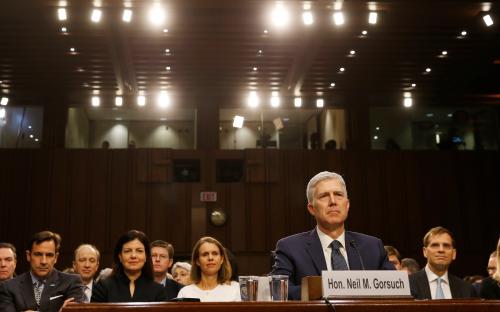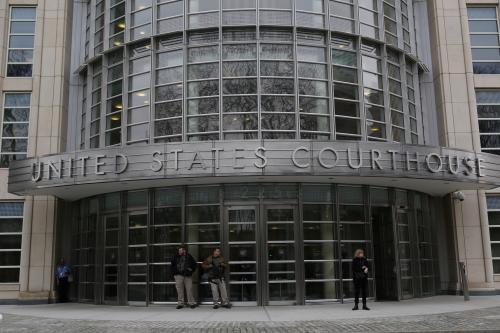The Senate Republicans provided President Trump with the most significant victory of his first three months as President: the approval of Neil Gorsuch as associate justice of the Supreme Court. The Senate also approved Trump’s Cabinet and several other top nominees, and approved a set of bills to overturn Obama-era regulations. This record, however, foreshadows great challenges to come as the Republicans attempt to move major legislation through Congress.
The Gorsuch Nomination
President Trump’s biggest accomplishment was also his easiest. Trump just picked one of the names off his list of Federalist Society-approved judges, made a reality television-worthy announcement, and let the Senate Republicans take it from there.
Of course, Senate majority leader Mitch McConnell and the rest of the Republican conference deserve credit (or blame, depending on one’s point of view) for the empty seat on the Supreme Court. Gorsuch was nominated to take the seat of Antonin Scalia, who died February 13, 2016. President Obama nominated Merrick Garland for the seat on March 16, 2016. The Senate Republicans then took the extraordinary action of doing nothing: no hearings, no floor votes, no justice. Instead, they declared that the 2016 presidential election was a referendum on the open seat. And when the Democratic candidate for President garnered more popular votes in that referendum, they continued to ignore the Garland nomination.
The short-term payoffs to Trump and the Senate Republicans for the Gorsuch victory were immense. They had achieved a basic promise and redeemed the reluctant faith that many Republican voters placed in Trump. However, it came at two great costs: first, it highlighted the partisan nature of the modern Supreme Court. As a practical matter, the highest court now features a 5-4 Republican majority, with the last seven appointments occurring when the President was in the same party as the Senate majority. The Supreme Court’s influence derives from its perceived objectivity and expertise; the Senate’s disregard of Garland and partisan confirmation of Gorsuch diminishes this reputation.
Nominations with more “nay” votes than ever
When Alexander Acosta was approved as Secretary of Labor on April 27, 2017, the Senate finished its approval of Trump’s Cabinet. Several of these nominees were highly controversial, especially Jeff Sessions (Attorney General), Betsy Devos (Education), Andrew Puzder (Labor-withdrawn) Acosta (Labor), Tom Price (Health and Human Services), Steve Mnuchin (Treasury), and Rex Tillerson (State). Overall, there were more “nay” votes against Trump’s Cabinet nominees than ever before.
Due to a precedent set in 2013, the Democrats were unable to filibuster these controversial nominations because a simple majority of the Senate can limit debate on an executive branch nomination, or on appointees to the federal district or appellate courts. However, the Democrats availed themselves of opportunities to force cloture votes on many of Trump’s nominees, even those who went on to be approved by wide margins. The cumulative effect of this tactic was to slow down the Senate, thereby keeping the Trump administration understaffed and denying the Senate majority the floor time it could have used to pass more legislation. As then-Senate minority leader Mitch McConnell (R-KY) demonstrated in 2009-10, the Senate minority’s best hope is to run out the clock and win reinforcements in the next midterm election. The Democrats have learned from McConnell’s playbook.
Overturning Obama Regulations
While the Senate waited for the House to write a bill to repeal and replace the Affordable Care Act, its main legislative activity has been to overturn thirteen regulations approved during the last eight months of the Obama administration. The 1996 Congressional Review Act (CRA) allows Congress to reverse regulations adopted during the last sixty days of Congressional activity; Congress’s light 2016 schedule extended the reach of the law to regulations enacted since May 2016. Like budget bills, these CRA bills cannot be filibustered in the Senate. Some examples of regulations overturned are:
- The Stream Protection Rule, which restricts coal mining’s effect on the surrounding environment.
- A regulation forcing oil and gas companies to disclose their energy contracts with foreign governments
- A rule allowing the Social Security administration to provide the Justice Department with the names of people who a) receive payments because they are mentally incapable of working and b) designate someone else to receive their checks. These individuals would have been prevented from purchasing firearms by the Justice Department.
- A rule restricting Internet companies from sharing customers’ web profile without consent.
- Two rules prohibiting states from a) requiring drug tests for unemployment insurance benefits b) prohibiting Planned Parenthood from providing government-funded medical services.
The policy impact of these CRA bills vary, but they share a critical feature: they reject rather than affirm. As such, they are very simple legislative vehicles; the executive branch makes the proposal and Congress chooses to say “no.” This is much simpler than Congress drafting and passing legislation that expresses Congressional preferences on these policy issues.
What Comes Next?
The first 100 days of Trump’s presidency featured items that cannot be filibustered: a budget resolution, CRA bills, and nominations. The single noteworthy exception was the Gorsuch nomination, which was vulnerable to a filibuster…until the Senate Republicans decided that it was not. Going forward, Trump and the Republicans will turn to issues that can be filibustered in the Senate, beginning with a bill to fund the government through October. Tax reform legislation and infrastructure spending could conceivably be enacted as budget reconciliation legislation, but most other legislation requires some Democratic support. And neither Trump nor the Senate Republicans have shown much ability to negotiate with the Democrats to develop legislation that both parties support. As Trump’s approval ratings decline, the Democrats will be emboldened to strike hard bargains when the Republicans come to the table—or no bargains at all.
Nor is further reform a viable strategy for the Republicans. During the Gorsuch fight, a bipartisan group of 61 senators expressed support for maintaining the right to filibuster on legislation. As I show here, the distinctive feature of this group is that there does not seem to be a clear pattern in their support for the filibuster. Republicans and Democrats, young and old, safe states and swing states…support for the legislative filibuster spans the Senate.
Meanwhile, the clock is ticking on Trump’s presidency and the 115th Congress. There are hundreds of nominations to come, each subject to multiple roll call votes and hours of debate time. The Congressional agenda is clogged with complex issues that require slow deliberation and compromises. Every day that passes takes the Senate farther from Trump’s electoral victory and closer to a midterm election that looks like a Democratic wave. It has only been a hundred days for Trump, but at this rate his best days in the Senate may already be behind him.
The Brookings Institution is committed to quality, independence, and impact.
We are supported by a diverse array of funders. In line with our values and policies, each Brookings publication represents the sole views of its author(s).











Commentary
Trump running out of low-hanging fruit in the Senate
May 5, 2017